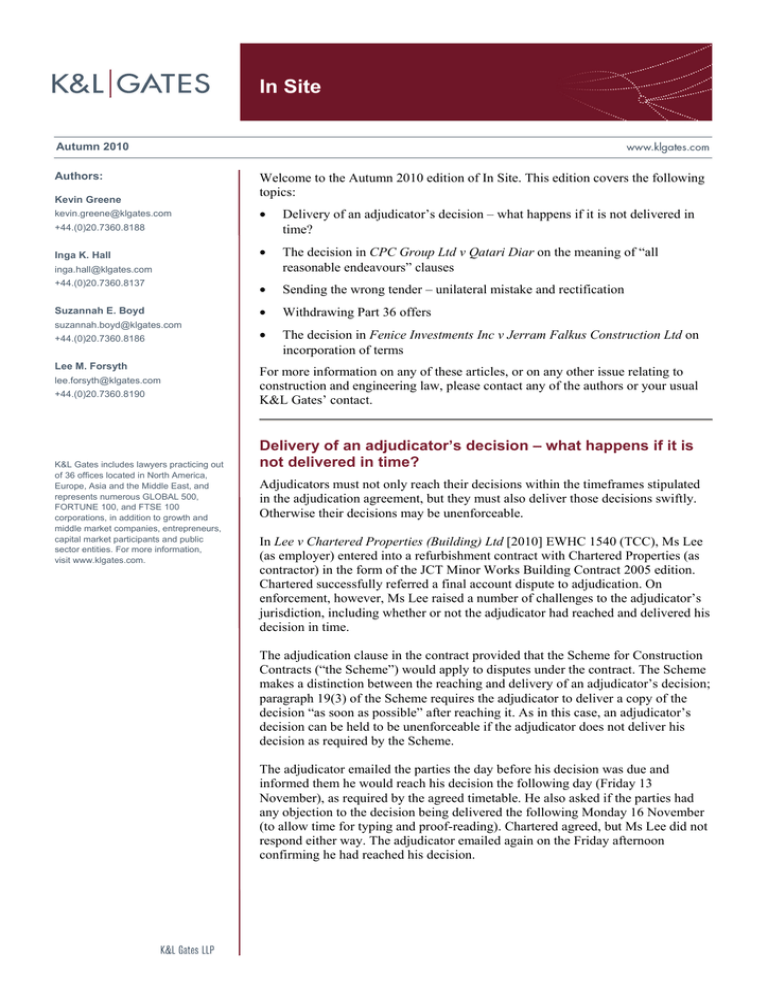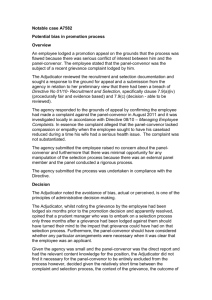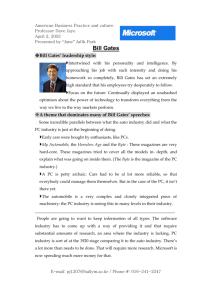
In Site
Autumn 2010
Authors:
Kevin Greene
Welcome to the Autumn 2010 edition of In Site. This edition covers the following
topics:
•
Delivery of an adjudicator’s decision – what happens if it is not delivered in
time?
•
The decision in CPC Group Ltd v Qatari Diar on the meaning of “all
reasonable endeavours” clauses
+44.(0)20.7360.8137
•
Sending the wrong tender – unilateral mistake and rectification
Suzannah E. Boyd
•
Withdrawing Part 36 offers
•
The decision in Fenice Investments Inc v Jerram Falkus Construction Ltd on
incorporation of terms
kevin.greene@klgates.com
+44.(0)20.7360.8188
Inga K. Hall
inga.hall@klgates.com
suzannah.boyd@klgates.com
+44.(0)20.7360.8186
Lee M. Forsyth
lee.forsyth@klgates.com
+44.(0)20.7360.8190
K&L Gates includes lawyers practicing out
of 36 offices located in North America,
Europe, Asia and the Middle East, and
represents numerous GLOBAL 500,
FORTUNE 100, and FTSE 100
corporations, in addition to growth and
middle market companies, entrepreneurs,
capital market participants and public
sector entities. For more information,
visit www.klgates.com.
For more information on any of these articles, or on any other issue relating to
construction and engineering law, please contact any of the authors or your usual
K&L Gates’ contact.
Delivery of an adjudicator’s decision – what happens if it is
not delivered in time?
Adjudicators must not only reach their decisions within the timeframes stipulated
in the adjudication agreement, but they must also deliver those decisions swiftly.
Otherwise their decisions may be unenforceable.
In Lee v Chartered Properties (Building) Ltd [2010] EWHC 1540 (TCC), Ms Lee
(as employer) entered into a refurbishment contract with Chartered Properties (as
contractor) in the form of the JCT Minor Works Building Contract 2005 edition.
Chartered successfully referred a final account dispute to adjudication. On
enforcement, however, Ms Lee raised a number of challenges to the adjudicator’s
jurisdiction, including whether or not the adjudicator had reached and delivered his
decision in time.
The adjudication clause in the contract provided that the Scheme for Construction
Contracts (“the Scheme”) would apply to disputes under the contract. The Scheme
makes a distinction between the reaching and delivery of an adjudicator’s decision;
paragraph 19(3) of the Scheme requires the adjudicator to deliver a copy of the
decision “as soon as possible” after reaching it. As in this case, an adjudicator’s
decision can be held to be unenforceable if the adjudicator does not deliver his
decision as required by the Scheme.
The adjudicator emailed the parties the day before his decision was due and
informed them he would reach his decision the following day (Friday 13
November), as required by the agreed timetable. He also asked if the parties had
any objection to the decision being delivered the following Monday 16 November
(to allow time for typing and proof-reading). Chartered agreed, but Ms Lee did not
respond either way. The adjudicator emailed again on the Friday afternoon
confirming he had reached his decision.
In Site
On the following Monday afternoon he delivered
the decision (by email), which was stated to be
“made the 13 November 2009 under my hand”.
Akenhead J held that, in the circumstances of the
case, with a delay of 74 hours, it could not be said
that the adjudicator had delivered a copy of his
decision “as soon as possible after” he reached it
and, therefore, the decision was unenforceable.
There was no evidence why the adjudicator
needed 3 days to undertake word processing and
delivery (especially as he worked for a large firm
of quantity surveyors and had access
to their facilities).
In reaching his decision, the judge followed the
decisions reached in previous cases on similar
issues. In Mott MacDonald Ltd v London &
Regional Properties Ltd [2007] EWHC 1055
(TCC), for example, HHJ Thornton QC held (in
relation to a decision delivered 1 day after it was
reached): “…any delay after the end of the
relevant adjudication period in delivering the
decision must be minimal…any failure to comply
with the requirement of prompt and rapid
delivery will render the decision
unenforceable…”.
The key point here is that both parties to an
adjudication need to agree to extend the time for
the adjudicator to deliver his decision, or the
adjudicator must provide a very good reason why
the decision could not be delivered close to the
time it was reached. Administrative problems are
unlikely to be sufficient. As the judge
commented, even“if the Decision (which would
be unlikely and somewhat unusual) had been
drafted in long hand, there is no good reason why
it could not have been faxed or scanned and emailed over to the parties.”
The decision in CPC Group Ltd v
Qatari Diar on the meaning of “all
reasonable endeavours” clauses
The well-publicised case of CPC Group Ltd v
Qatari Diar Real Estate Investment Company
[2010] EWHC 1535 (Ch) adds to our
understanding of what it means to use “all
reasonable endeavours”.
In 2007 CPC and Qatari Diar (“QD”) entered into
a joint venture agreement to acquire and
redevelop the Chelsea Barracks in Westminster.
This case centred on whether QD had acted in
breach of a sale and purchase agreement in
withdrawing its planning application after the
intervention of the Prince of Wales in opposing
the redevelopment. Under that agreement, QD
owed CPC an obligation to use “all reasonable
but commercially prudent endeavours” to enable
certain threshold events to be achieved (which
relied mainly on QD’s progress in obtaining
planning permission for the redevelopment).
Cases such as Rhodia International Holdings Ltd
v Huntsman International LLC ([2007] EWHC
292 Comm) have established that, in the range of
different types of “endeavours” clauses included
in contracts, “best endeavours” represents the
most stringent obligation and “reasonable
endeavours” the least stringent. As far as the
middle ground is concerned, an obligation to use
“all reasonable endeavours” may well equate to
best endeavours in terms of the number of
reasonable courses of action that should be taken
(Rhodia, obiter), but the two obligations are
likely to differ as to the extent to which the party
owing the obligation is obliged to sacrifice its
own commercial interests in complying with it
(Yewbelle Limited v London Green
Developments ([2007] EWCA Civ 475).
Although that may not always be the case (the
other provisions of the contract and surrounding
commercial context also being relevant), the
Court in the present case held that the nature of
the obligation was made quite clear by the
inclusion of the “commercially prudent” words
which qualified the stringency of the obligation.
QD was, therefore, only required to take all
reasonable steps to procure planning permission,
provided such steps were commercially prudent.
The Court concluded that QD had complied with
this obligation and was entitled to consider its
own commercial interests (and not just those of
CPC) when deciding how to respond to the
Prince of Wales’ objections.
Sending the wrong tender –
unilateral mistake and rectification
The consequences of submitting the wrong
version of a tender was the subject matter of the
decision in Traditional Structures Ltd v H W
Construction [2010] EWHC 1530 (TCC).
Traditional Structures ("TSL") had been asked
by H W Construction ("HW") to provide a
quotation for “steelwork and roof cladding”.
TSL completed the tender, stating that it was a
tender for “the supply and delivery of structural
steelwork and claddings…”. By mistake,
however, the tender sent to HW only contained a
price for the steelwork (£37,573.43). TSL’s file
copy of the tender contained the steelwork price
and, written underneath, a separate roof cladding
price (£32,365.83).
Autumn 2010
2
In Site
HW made no mention of the missing roof
cladding price in a number of emails and
telephone calls to TSL. The tender was accepted
and TSL later invoiced HW with revised prices
for the steelwork and cladding following
variations. HW refused to pay on the grounds
that it had accepted the total as £37,574.43 as set
out in the tender.
The question, therefore, arose as to whether TSL
was bound to carry out the work for the price
stated in the contract or whether, as TSL argued,
the unilateral mistake should be rectified and the
price increased to include the missing roof
cladding price.
For a rectification claim to succeed, there needed
to be evidence of a mistake by one party, together
with evidence that the other party had knowledge
of the mistake, but chose to say nothing, or
looked the other way in order to make some
personal gain. In this context, “knowledge”
means deliberately failing to ask the questions
that an honest man would ask or shutting one’s
eyes to the obvious. If there is no actual
knowledge, then there has to be a finding of
dishonesty or a degree of sharp practice of a type
that goes beyond the boundaries of fair dealing.
After undertaking a detailed review of the tender
document wording, the parties’ correspondence
and witness evidence, the judge found that HW’s
managing director “wilfully and recklessly failed
to enquire” whether the tender price included the
price of the cladding works, and “shut his eyes to
the obvious”, the obvious being that the price
quoted was demonstrably or self-evidently a price
that related only to structural steelwork.
The judge held, therefore, that HW had actual
knowledge of the mistake and, as this was
unconscionable, the mistake was rectified.
This case provides a useful yardstick as to what
the courts regard as unfair in commercial
dealings. Cases such as this are rare, but it
demonstrates the courts’ willingness to rectify a
contract to reflect a more reasonable position.
Withdrawing Part 36 offers
Part 36 sits apart from ordinary contractual
principles and the general rules that apply when
making a contractual offer. This was clearly
affirmed in Gibbon v Manchester City Council
[2010] EWCA Civ 726.
In the Gibbon case, the claimant made a Part 36
offer on 18 November 2008 to accept £2,500.
The defendant rejected this offer and made a
number of counter-offers to the claimant. The
claimant rejected the highest of these offers (also
£2,500) on 18 February 2009 and, on 26
February, the defendant purported to accept the
claimant's 18 November offer of £2,500.
A key point in this case was that the claimant
had not at any time formally withdrawn her 18
November offer. She argued, however, that, as
the defendant had previously rejected that offer,
it was incapable of acceptance thereafter under
ordinary contractual principles.
CPR 36.9(2) states that “…a Part 36 offer may
be accepted at any time (whether or not the
offeree has subsequently made a different offer)
unless the offeror serves a notice of withdrawal
on the offeree”. The Court held that this rule is
quite clear and an offer remains open for
acceptance at any time – notwithstanding the
offeree rejecting the offer or making a different
offer - unless and until written notice of the
withdrawal (or change of terms of the offer) is
served on the offeree in accordance with CPR
36.3(7). In the Gibbon case, the claimant did not
ever formally withdraw her 18 November offer
and it therefore remained open for acceptance
notwithstanding the intervening events.
The Court held that the requirement to serve a
written notice of withdrawal under CPR 36.3(7)
left no room for the concept of implied
withdrawal and, as such, the claimant’s 18
February letter rejecting the defendant’s offer of
£2,500 could not constitute an implied
withdrawal of her earlier offer for
the same amount.
It did not refer to the 18 November offer and did
not contain any language that could be construed
as a notice of withdrawal.
Part 36 of the Civil Procedure Rules enables
claimants and defendants to make settlement
offers, and sets out the steps which must be
followed to accept, or withdraw, such offers.
Autumn 2010
3
In Site
The decision in Gibbon illustrates how different
Part 36 offer and acceptance is to the general
contractual approach, with the Court explaining:
“Part 36 allows a defendant (or for that matter a
claimant) to decide whether to leave his offer
open for acceptance or to withdraw it and make
another offer later. To import into Part 36 the
common law rule that an offer lapses on rejection
by the offeree would undermine this important
element of the scheme. It could give rise to
disputes about whether the offer had been
rejected in any given case so as render it
incapable of acceptance.”
It is important to keep all Part 36 offers under
close review and formally withdraw any which
are no longer on the table. The decision is helpful
as it gives guidance as to what a notice of
withdrawal should include to avoid uncertainty,
with the Court stating that “[a]lthough the rule
does not prescribe any particular form of notice,
in order to avoid uncertainty it should include an
express reference to the date of the offer and its
terms, together with some words making it clear
that it is withdrawn.”
The decision in Fenice Investments
Inc v Jerram Falkus Construction
Ltd on incorporation of terms
The decision in Fenice Investments Inc v Jerram
Falkus Construction Ltd [2009] EWHC 3272
(TCC) is a reminder of the importance of
ensuring that contract amendments are properly
incorporated into the contract and that bespoke
clauses do not fall foul of order of priority
clauses.
The parties in this case contracted under a JCT
Design and Build Contract (Revision 1) 2007
form of contract. As well as agreeing an
amendment to JCT clause 4.10.1 extending the
payment period from 14 to 21 days, a detailed
payment “evaluation procedure” was tucked
away in the Employer’s Requirements. This
stipulated a different (and later) starting point for
the calculation of the final date for payment and
also gave the employer’s agent control over the
timescale for issuing a withholding notice.
Significantly, the JCT order of priority clause
(clause 1.3) was left un-amended and stated that
nothing contained in the Employer’s
Requirements overrides or modifies the
Agreement or Conditions. In the event of conflict,
therefore, the JCT Conditions prevailed.
A dispute arose in respect of an interim payment
application as to whether Fenice (the Employer)
had issued a withholding notice on time, which
in turn depended on how the payment
mechanism was to be interpreted. The basic
point of difference between the parties was that,
if the JCT Conditions applied, the withholding
notice was late, whereas, if (as Fenice
contended) the payment mechanism contained in
the Employer’s Requirements applied, the
withholding notice had been issued within time.
The dispute was referred to adjudication. The
adjudicator agreed with Falkus (the contractor)
but Fenice did not pay the sum awarded, instead
seeking CPR Part 8 declarations that its
interpretation of the contract was correct (and,
therefore, that the adjudicator’s was wrong).
Coulson J found that the two sets of payment
provisions fundamentally conflicted with each
other and could not operate together. Although
the general rule is that a term specifically drafted
for a contract takes precedence over a standard
term, here there was an express agreement to the
contrary -the order of priority clause - and the
judge found no reason why it should not be
applied in order to resolve the conflict.
Accordingly, he found that the contractor’s
interpretation of the payment provisions was to
be preferred and enforced the
adjudicator’s decision.
This suggests, of course, that the decision in this
case would have been different if Fenice had
incorporated their payment mechanism as an
amendment to the JCT Conditions themselves, as
then the order of priority clause would not have
operated against them. Owing to the nature of
this particular amendment, however, Coulson J
indicated that this may not necessarily have been
the case. He said that, even if he was wrong
about which payment mechanism was
incorporated into the contract, he did not
consider that the payment mechanism in the
Employer’s Requirements would be an
“adequate mechanism for determining what
payments become due under the contract, and
when” as required by section 110 of the Housing
Grants, Construction and Regeneration Act 1996
because the payment period could effectively be
extended at will by Fenice. As such, it would not
be enforceable under the Act.
Autumn 2010
4
In Site
Anchorage Austin Beijing Berlin Boston Charlotte Chicago Dallas Dubai Fort Worth Frankfurt Harrisburg Hong Kong London
Los Angeles Miami Moscow Newark New York Orange County Palo Alto Paris Pittsburgh Portland Raleigh Research Triangle Park
San Diego San Francisco Seattle Shanghai Singapore Spokane/Coeur d’Alene Taipei Tokyo Warsaw Washington, D.C.
K&L Gates includes lawyers practicing out of 36 offices located in North America, Europe, Asia and the Middle East, and represents numerous
GLOBAL 500, FORTUNE 100, and FTSE 100 corporations, in addition to growth and middle market companies, entrepreneurs, capital market
participants and public sector entities. For more information, visit www.klgates.com.
K&L Gates is comprised of multiple affiliated entities: a limited liability partnership with the full name K&L Gates LLP qualified in Delaware and
maintaining offices throughout the United States, in Berlin and Frankfurt, Germany, in Beijing (K&L Gates LLP Beijing Representative Office),
in Dubai, U.A.E., in Shanghai (K&L Gates LLP Shanghai Representative Office), in Tokyo, and in Singapore; a limited liability partnership (also
named K&L Gates LLP) incorporated in England and maintaining offices in London and Paris; a Taiwan general partnership (K&L Gates)
maintaining an office in Taipei; a Hong Kong general partnership (K&L Gates, Solicitors) maintaining an office in Hong Kong; a Polish limited
partnership (K&L Gates Jamka sp. k.) maintaining an office in Warsaw; and a Delaware limited liability company (K&L Gates Holdings, LLC)
maintaining an office in Moscow. K&L Gates maintains appropriate registrations in the jurisdictions in which its offices are located. A list of the
partners or members in each entity is available for inspection at any K&L Gates office.
This publication is for informational purposes and does not contain or convey legal advice. The information herein should not be used or relied
upon in regard to any particular facts or circumstances without first consulting a lawyer.
©2010 K&L Gates LLP. All Rights Reserved.
Autumn 2010
5





